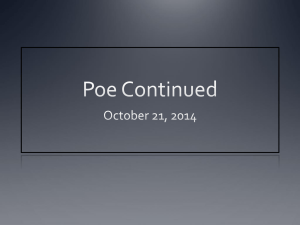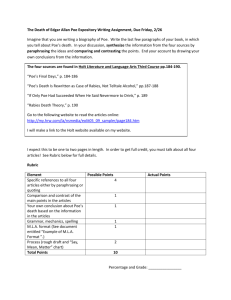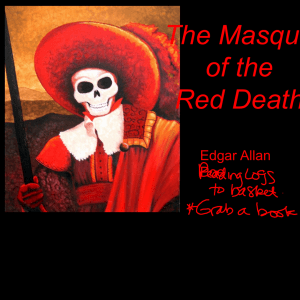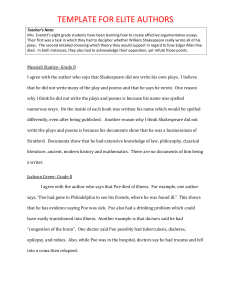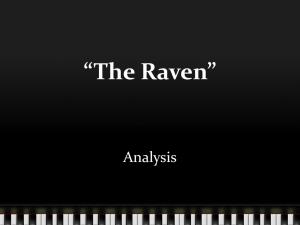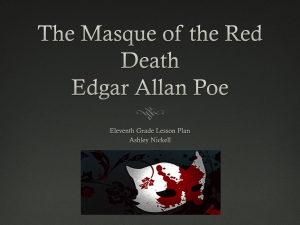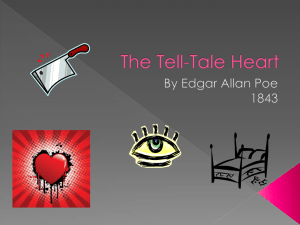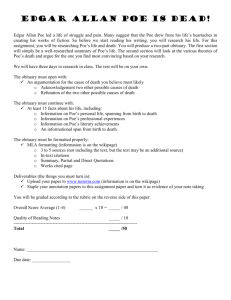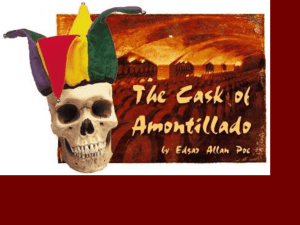10. Why does the Prince die BEFORE Death does anything?
advertisement
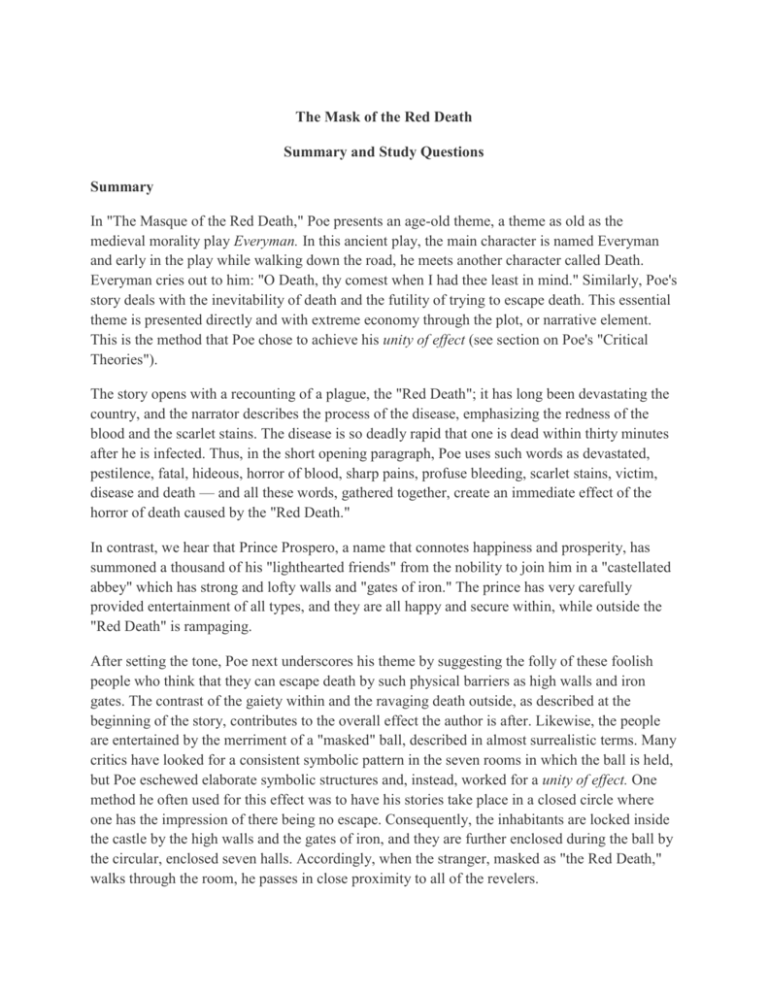
The Mask of the Red Death Summary and Study Questions Summary In "The Masque of the Red Death," Poe presents an age-old theme, a theme as old as the medieval morality play Everyman. In this ancient play, the main character is named Everyman and early in the play while walking down the road, he meets another character called Death. Everyman cries out to him: "O Death, thy comest when I had thee least in mind." Similarly, Poe's story deals with the inevitability of death and the futility of trying to escape death. This essential theme is presented directly and with extreme economy through the plot, or narrative element. This is the method that Poe chose to achieve his unity of effect (see section on Poe's "Critical Theories"). The story opens with a recounting of a plague, the "Red Death"; it has long been devastating the country, and the narrator describes the process of the disease, emphasizing the redness of the blood and the scarlet stains. The disease is so deadly rapid that one is dead within thirty minutes after he is infected. Thus, in the short opening paragraph, Poe uses such words as devastated, pestilence, fatal, hideous, horror of blood, sharp pains, profuse bleeding, scarlet stains, victim, disease and death — and all these words, gathered together, create an immediate effect of the horror of death caused by the "Red Death." In contrast, we hear that Prince Prospero, a name that connotes happiness and prosperity, has summoned a thousand of his "lighthearted friends" from the nobility to join him in a "castellated abbey" which has strong and lofty walls and "gates of iron." The prince has very carefully provided entertainment of all types, and they are all happy and secure within, while outside the "Red Death" is rampaging. After setting the tone, Poe next underscores his theme by suggesting the folly of these foolish people who think that they can escape death by such physical barriers as high walls and iron gates. The contrast of the gaiety within and the ravaging death outside, as described at the beginning of the story, contributes to the overall effect the author is after. Likewise, the people are entertained by the merriment of a "masked" ball, described in almost surrealistic terms. Many critics have looked for a consistent symbolic pattern in the seven rooms in which the ball is held, but Poe eschewed elaborate symbolic structures and, instead, worked for a unity of effect. One method he often used for this effect was to have his stories take place in a closed circle where one has the impression of there being no escape. Consequently, the inhabitants are locked inside the castle by the high walls and the gates of iron, and they are further enclosed during the ball by the circular, enclosed seven halls. Accordingly, when the stranger, masked as "the Red Death," walks through the room, he passes in close proximity to all of the revelers. The importance of the seven rooms lies in the seventh and, therefore, the last room. As the narrator describes the rooms, we are told that the window panes look out onto the hall rather than the outside world, and that they take on the colors and hues of the decoration of each room. The first room is decorated in blue and the stained glass has a blue hue. The second is purple and so "the panes are purple." And this continues through the green room (third), the orange room (fourth), the white room (fifth), and the violet room (sixth). However, the seventh room is different. Here the apartment is "shrouded in black velvet," but the panes are "scarlet — a deep blood-color." Furthermore, this black chamber is the most westernly and "the effect of the firelight upon the blood tinted panes is ghastly in the extreme, and produces so wild a look upon the countenance of those who enter it that there are few . . . bold enough to set foot within it." Poe's purpose in these descriptions, particularly the black room, has no relation to reality. In reality, no such place as the black room would be used as a part of a ballroom. But Poe wants to achieve an effect — a total, unified effect — in order to show the close proximity of the revelry of life and the masquerade to the inevitability of death itself. As noted above, therefore, regardless of whether or not the first six rooms have any symbolic function, the significance of the seventh room cannot escape the reader's attention. Black usually symbolizes death, and it is usually used in connection with death. Moreover, in describing the black decor of the room, the narrator says that it is shrouded in velvet, shrouded being a word always referring to death. Likewise, the window panes are "scarlet — a deep blood color." This is an obvious reference to the "Red Death." When the masked "Red Death" makes his appearance, he moves rapidly from the Eastern room (symbolic of the beginning of life) to the Western room (symbolic of the end of life). In conjunction with man's quick and brief journey through life is the rapid passing of time, represented by the black clock; every time the clock strikes the hour, the musicians quit playing and all of the revelers momentarily cease their celebrating. It is as though each hour is "to be stricken" upon their brief and fleeting lives. To emphasize the brevity of life, the fleeting of life and time, and the nearness of death, Poe reminds the reader that between the striking of each hour, there elapses "three thousand and six hundred seconds of the Time that flies." In spite of all things, the masqueraders continue their gaiety and revelry. Here, note Poe's description: The guests have donned costumes that are often grotesque; there is "much glare and glitter and piquancy and phantasm"; there are "arabesque figures" and "madman fashions." Poe describes the party in terms of "delirious fancies" and as "beautiful . . . wanton . . . bizarre . . . terrible, and not a little of that which might have excited disgust." These descriptions are reminiscent of orgies which are described in other great Romantic works (in Goethe's Faust, Pushkin's Eugene Onegin, Byron's Childe Harold, for example). Furthermore, because the maskers are so bizarre themselves, when the mask of the "Red Death" appears, it is shocking. The reader discovers that this "guest" is even more fantastic and strange than all the other guests. He is horrendous by comparison. Significantly, the appearance of the "Red Death" at midnight is propitious and symbolic. This is the end of the day and, by analogy, the end of life. His appearance strikes a note of "terror, of horror, and of disgust." The figure is "shrouded from head to foot in the habiliments of the grave." His mask is that of a corpse which, we gather, died from the Red Death and to create more horror, his entire outfit is sprinkled with blood and "all the features of the face were besprinkled with the scarlet horror." Again, the reader should note how effectively Poe, by his choice of words, captures man's universal fear of death and its horrors. When Prince Prospero sees the stranger, he is indignant at such an intrusion. (It would almost be too simplistic to say that all people are indignant at the intrusion of death on their lives.) The prince immediately instructs the stranger to be seized, but all are universally frightened to seize this Red Death. Infuriated, the prince draws a dagger and rushes 'hurriedly through the six chambers," but as he approaches the figure, his dagger stops, and he falls dead upon the black carpet. The other revelers fall upon the black "mummer" but to their "unutterable horror," they find nothing under the shrouds or behind the corpse-like mask. One by one, all of them drop dead. The "Red Death," Poe tells us, holds "illimitable dominion over all." Poe's story possesses no real characters. The greatness of the story lies in his use of an age-old theme — the inevitability of death — and in the way that Poe creates and maintains a total unity of effect, he brings us into the horror of the story. The story makes no effort to present a realistic view of any known aspect of life. We do not even know what country the story takes place in, but, due to the name of the prince, we assume it to be a southern European country. The story achieves credibility simply through Poe's powerful unity of effect that he creates so marvelously. Each word of each description contributes to one single, unified mood of fear and horror. An atmosphere of strangeness, a bizarre situation, and an evocative style all combine to make this one of Poe's most effective stories. Study Questions 1. What does the Prince hope to do by locking himself in the castle? Why would he have the doors barred from the outside as well? Beyond physical safety, what is Prince Prospero attempting to do by leaving everything but merriment outside? 2. Describe exterior of the castle. What do they have around the exterior? Usually, what would this setup be preparing for? What is the significance of this? 3. Describe the layout of the interior. How many rooms are there, what are their colors, etc.? 4. What is the significance of the blood-red room being in the west? Why do the men avoid the blood-red room? Think about what it symbolizes. 5. What does the clock symbolize? What does the chiming of the clock interrupt? What does this remind the people of? 6. This entire story was greatly influenced by the thinking of Shakespeare. Shakespeare, in one of his plays, suggests that there are seven stages to life. How does Poe use this idea in his story? 7. Prospero, the main character from Shakespeare’s, The Tempest, puts on a masque for his daughter and soon-to-be son-in-law. At the conclusion of his masque, he says that everything eventually fades and is forgotten, ending with “We are such stuff/ As dreams are made on, and our little life/ Is rounded with a sleep,” suggesting that life is made up of our dreams. What relevance does this have to the story? 8. Based on what they are trying to avoid, why is it so unacceptable that someone is dressing up like Death? 9. What is the significance of the Prince chasing the masked man from the eastern-most room to the second to last room in the west? Symbolically, what has he done? 10. Why does the Prince die BEFORE Death does anything? Consider his goals when answering. Additional questions to consider: There’s not just one right answer. Justify your responses. 1. Can you relate to Prince Prospero, or to anyone in this story? Are there any genuine characters? 2. Is Prince Prospero a tragic hero, or a fool? What is his primary flaw? Does he have one? 3. What is the relationship between art and death in "The Masque of the Red Death"? 4. Is Prince Prospero Poe? Is Poe Prince Prospero? If "The Masque of the Red Death" is a dream, whose dream is it? 5. Is "The Masque of the Red Death" apocalyptic? Does it present a challenge to traditional ideas of the end of the world, or is it a fairly traditional vision itself? 6. Is fear Poe's intended effect in "The Masque of the Red Death"? Or does he have another one? 7. Is "The Masque of the Red Death" scary?
